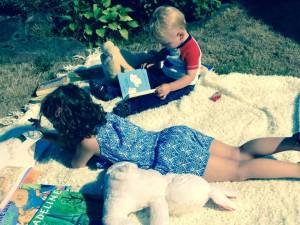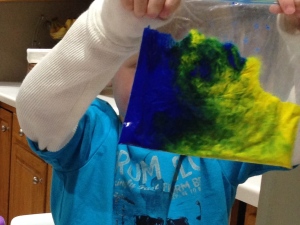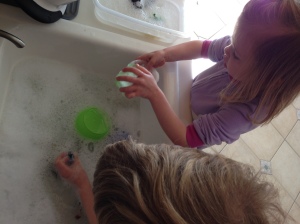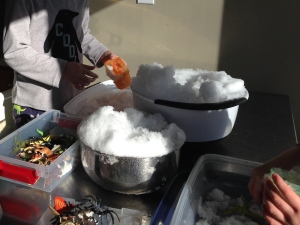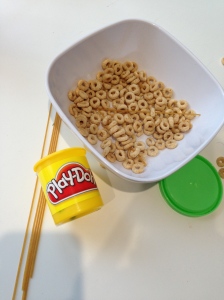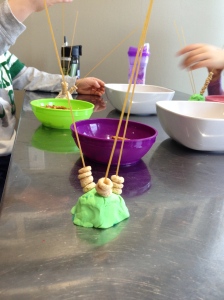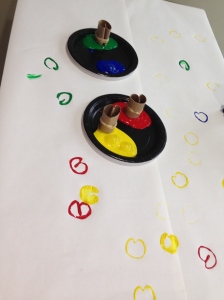Dear Courtney,
Fall is a bittersweet time for me. This is my second fall not returning to work as a middle school English teacher, and as friends post pictures of their classrooms or of carts filled with school supplies, I can’t help but feel flashes of envy. There is something thrilling about the start of a new school year; it has an energy I love.
Every year I was a teacher, parents came to Back to School Night armed with the same question: “How can I support my kid at home?” And every year, for twelve years, I gave the same answer: “Read. Read to them. Read with them. Read around them. Listen to them read. Talk about what you read. Create a place for reading. Create a time for reading. Encourage them to read.”
Success in school (in life?) lives and dies on a child’s ability to read. Luckily, we as parents can do a lot to grow strong readers and, by extension, strong thinkers.
So whether your kid is an avid, under the covers with a flashlight reader, or a reluctant, fake and fight her way through reader, here are a few tips for creating a literacy rich environment at home.
If you don’t want to read the whole post,here is a list of categories as they appear below.
Tips for all ages
Preschool/Pre-reader
Early and Elementary Readers
Middle School Readers
Reluctant/Resistant Readers
Tips for All Ages
Fill your home with text. Now don’t roll your eyes at the obviousness of this statement. Notice the word I used? Text. As in, not just books. Fill your home with books, magazines, field guides, news papers, online subscriptions, resource books, maps, blogs (thank you for reading!), etc. Make your home, what we in the biz call, a text rich environment.
Read out loud. Yes, even to your teenager. For some reason we tend to stop reading to kids once they start reading to themselves. For some reason we decide it is too juvenile an activity for older children, but people LOVE to listen to stories. Our local library started doing adult read aloud times– and people go. Ever listen to This American Life or StoryCorp on NPR? Ever pop-in a book on CD for a long car ride? It is enjoyable to listen to someone read, and bonus, it can be really bonding. So read to your kids regardless of age!
Talk about what you read. It is easy to read (especially fiction) like we watch TV, without much thought, but it is important for kids to engage their minds while they read. Ask your kids questions like, “What problem is the main character facing? How do you think he/she will solve that?” or “What do you think this book/chapter/section is trying to teach us about life/the world/this subject?” or “What is your favorite part? Why?”
You get the idea. There are tons of ways to talk about reading. But do it. Talk.
Preschool/Pre-reader
Read ALL the time. Reading doesn’t have to just happen at bedtime. Read at the breakfast table, during bath time, while they play with playdough or color. Not only will the reading minutes add up, but it will help your kids to develop listening and multitasking skills. It doesn’t matter where you are, find moments throughout the day to engage with books and stories.
Get books on CD from the library. Next time you need a few moments of peace, instead of popping in Frozen, try a book on CD. Kids love the independence of it; they can “follow” along and the beeps will tell them when to turn the page. (Double bonus: while they listen YOU can use the bathroom solo!).
Use Google. Books are FULL of context kids don’t know and can’t visualize. It’s one of the things that makes reading so important, but can also make it difficult. I’ll never forget when my mom explained a canyon to me like this, “it’s kind of like a huge ditch in the Earth with really tall, rocky sides.” I envisioned a massive roadside ravine (something I was familiar with) until we moved to Colorado, and I finally saw a canyon with my own eyes! Now, with the magic of Google, kids can see prairies and inlets and space shuttles and violets without ever leaving their living room! Give kids context and you unlock reading in a whole new way!
Play car games with letters or site words. Words are everywhere. Take advantage of that. See who can find the most Ts before the next stop light. Search the world for words like the, and, end, to, go, is, etc. There are tons of sight words, and knowing them will make the transition from pre-reading to reading so much smoother!
Be patient! Early readers are inconsistent! They’ll recognize a word one day and forget the next. One moment they’ll know all their sounds and the next they’ll claim B says mmmmmmm. This is normal! Gently correct and then move one.
Early and Elementary Readers
Read with them. Reading to your kid is still important, but you should also read with them. Take turns reading a book out loud. If your kid struggles with fluency and expression, read a page to her and then have her read it back.
Read a series. The great thing about series books is they are typically pretty formulaic. Once a kid reads one, the others become easier to read and understand. This makes series books a great way to practice fluency and comprehension!
Remember the Rule of Thumb. Your kid may come home from school with a reading level, and depending on the system the school uses that level may be a number or a letter. While reading levels are important, not all books in the world are leveled, and even the ones that are may not be leveled with the same criteria used to level your kid. It can be difficult and confusing for parents to know what books match their kid’s level. So here’s the rule of thumb to remember: A book is probably at an appropriate level if your child can read it with about 97% accuracy. For younger elementary kids this means they don’t miss more than 3 words per book, and for older elementary kids it means they don’t miss more than about 3 words per page.
Don’t forget nonfiction. Most kids, most people, have a harder time reading non-fiction than fiction. Find non-fiction books or magazines on topics your kid is interested in. Read the books with them, or, if you don’t have time to do that, talk about the books together. Just remember, kids LOVE to look at the pictures in the non-fiction more than they love to read the words!
Middle School Readers (and High Schoolers too)
Read to them. I said it before, but I’ll say it again! Just because you kiddo is now in the land of lockers doesn’t mean you can’t still read aloud together!
Read with them. Unless your kids are really struggling you no longer need to sit side by side and listen to them read (though, if you want to, go for it!), but now is a good time to establish family book clubs, or if that doesn’t work for your family, ask for and then READ their book recommendations.
There are two reasons for this. First, if, like many parents of tweens and early teens, you suspect your child has been body snatched and replaced by a snarling, silent alien, reading the same book at least gives you something in common to talk about.
And second, your child is now entering the world of Young Adult (YA) lit, which is really fun to read, but often deals with young adult issues. Sex, drugs, drinking, dating, sexuality, differences– a lot of YA lit deals with these issues, and these books are great spring-boards for important conversations. Plus talking about the actions and choices of a fictional character is waaaay less emotional, intimidating and embarrassing for kids than talking about themselves!
Offer them a place in the “adult” club. Middle school kids want NOTHING more than to be all grown up. They want to be heard, and they want their opinion to matter. As parents we can use this to our advantage. Give your child an article and invite him to read it too. Say something like, “I read this article on the riots in Missouri, and it made me so mad because… I’d love to hear what you think. Would you read it and give me your opinion?”
Not only can this be a white dove offering to a difficult tween, it can also be a great opportunity for you to get insight into how your child is understanding and relating to the world.
Reluctant or Resistant Reader
Focus making reading enjoyable. If your kid HATES to read or is significantly behind, it will do no good to make reading at home miserable. Try to get material he likes– graphic novels, magazines, the sports page. And if he has to read something for class make deals to help him get it done. Deals like , “if you read the required book for 15 minutes, you can have a 5 minute break with the comic book.”
Try not to be the bad guy. The teacher may want your kid to read at her “just right” level, and in reality that is best, but when kids are behind the books at their level are often no fun to read. Leave the fight to the teacher; you focus on getting them to read something– anything. See the other tips, but series books, magazines, graphic novels, etc. are all great tools for getting reluctant readers reading.
Beware the fake reader. Reluctant readers are often amazing fakers. They will move their eyes and turn the pages, but in reality they come away with little comprehension. Encourage them to talk about the book– character names, plot lines, main ideas, settings, predictions– and if all else fails, pick up a copy and read it together. Reading something is better than reading nothing!
Celebrate even small success. There is a stigma attached to being a poor reader. Lots of adults will jokingly admit to being a terrible speller or horrible at math, but how many will say they’re poor readers? Kids feel this stigma too, and it beats them down. Even worse it can trick them into believing they’re stupid. Combat this with celebration! Celebrate every time they finish a book, move up a level, sound out a word correctly, use a new vocabulary word. It might feel artificial, but it matters.
This list is FAR from comprehensive! . Do you have favorite tips or resources for reading? Leave them in the comments section!
Cheers,
Natalie
Here are a few of my favorite online literacy resources
http://kids.nationalgeographic.com/
http://www.readingrockets.org/

